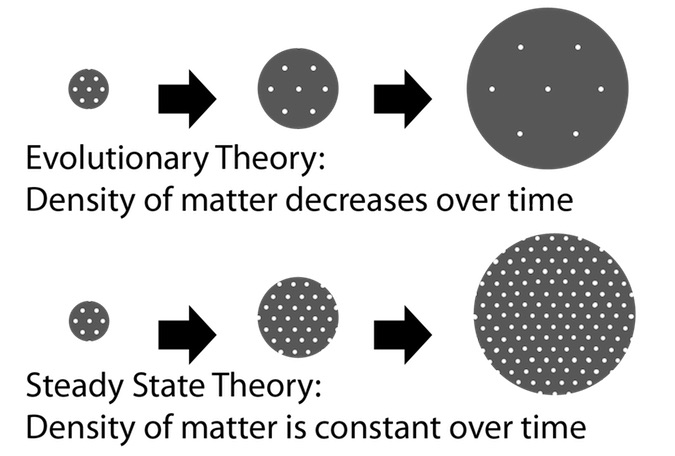Origin of Everything: Hot Bang or Ageless Universe?
Has the Universe always existed, or does it have a beginning, middle and an end? It's difficult to imagine a deeper mystery than this. However, this topic was recently discussed at the meeting of the National Academy of Sciences in Pasadena, California.
The case for an ageless, steady-state Universe was presented at the conference by astrophysicists Jesse L. Greenstein and physicist William A. Fowler of the California Institute of Technology. The steady state theory says the Universe forever looks much like it does today; this "steady state" theory competes with the "evolutionary" theory of the Universe. The evolutionary theory claims an initial collection of hot particles exploded at the dawn of time. These particles formed all the Universe's hydrogen (and perhaps helium) in one gigantic event.
Both theories explain – in entirely different ways – the fact that the Universe is expanding. This expansion was first detected in 1914, when American astronomer Vesto Melvin Slipher surveyed some galaxies and noticed the light from all of them was "red-shifted." All light travels in waves. In the spectrum of visible light, red light has the longest wavelength. If an object (such as a galaxy) is giving off light and the object is moving away, that motion lengthens the wavelengths, causing the light to "red-shift." It's similar to how the sound of a retreating locomotive drops in pitch as it passes by you.
In the steady-state theory the expansion comes from the continuous bubbling up of the element hydrogen, from empty space at a rate of one particle every cubic meter every 300,000 years or so. This hydrogen eventually gathers and condenses into stars. Through nuclear fusions in their cores, stars make all the heavier elements (e.g. carbon, oxygen, silicon, iron, copper, etc.) from this hydrogen. As stars age, die, and explode, they scatter the heavier elements around the galaxies. These heavier elements mix with hydrogen, and new stars form with rocky planets around them – like our own Solar System. As evidence of that process, Greenstein and Fowler referred to the heavy-element-making red giant stars which can be seen today in our own Galaxy.
An important point of the steady-state Universe is that it does change over time. Hoyle, the scientist who supports this theory, compares the deathless steady-state Universe to a river. It may appear unchanging, but there is plenty of movement and change under the surface. So, to borrow the old river saying, you can never step into the same Universe twice.
In contrast, there is the "evolutionary" theory of Russian-born American physicist George Gamow and his colleagues Ralph Alpher and Robert Herman. These scientists say the explosion and radioactive decay of a hot ball of neutrons at the birth of the Universe created all hydrogen and some helium. These elements formed as the blast expanded and cooled. The first stars were made of only this original hydrogen and helium. Those stars fused those original elements into new, heavier elements. These heavier elements were then scattered through the galaxies as the first stars died, and this led to the more complex mixtures of elements seen in stars now.

Image credit: NASA's Cosmic Times
Illustration of the matter-density history of the Universe according to the evolutionary theory (top) and the steady state theory (bottom). Click image for larger version.
This evolutionary theory also explains why galaxies are moving away from each other: they are all still in flight from the power of the initial blast. Newton's laws of motion help to explain this (an object in motion will remain in motion unless a force acts on it). There may be other direct evidence of the blast as well. Alpher and Herman have predicted that some faint left-over heat from that initial explosion may still exist in the form of stretched-out light waves called "microwaves" just a few degrees above absolute zero. However, no one has yet figured out a way to detect these left-over microwaves.
More evidence for the evolutionary Universe comes from Edwin Hubble's 1929 measurements of the speed of galaxies beyond our own. Hubble found that the farther away a galaxy is, the faster it appears to be moving away. This is exactly what would be expected if there was an ancient blast that started it all, and things have been moving away ever since.
The downside to an evolutionary Universe, of course, is that it doesn't end happily. There's no unlimited supply of hydrogen as in the steady state theory. In the evolutionary Universe, the Universe might expand forever and will eventually run out of hydrogen; the stars eventually burn out, and the Universe cools down to a vast frozen graveyard of dead stars. Another possibility for the evolutionary Universe is that the gravity of all matter might eventually pull everything back together again in a gigantic collapse that rebounds, explodes, and starts the Universe all over – this is the endlessly exploding and collapsing Universe described by the late physicist Richard Tolman from CalTech.
Which theory is correct? Only more research with bigger and better telescopes will tell. •
Click Here to read about Hoyle Scoffs at "Big Bang" Universe Theory



